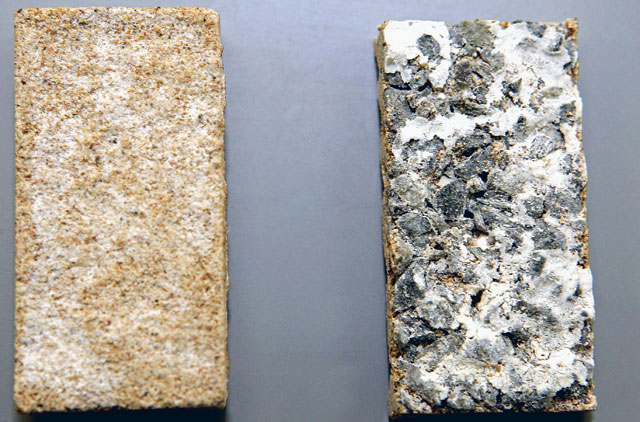
The bricks that we see today are most commonly made out of clay, but soon in the near future we may be able to see buildings made out of bacteria and waste products. Ginger Krieg Dosier wants to do just that. She's an assistant architecture professor at the American University of Sharjah (AUS) who has grown a brick by cultivating easily accessible bacteria, mixing it with waste products and dispensing it over dry sand.
Her sustainable creation has already been fruitful for Dosier as she recently won the 2010 Metropolis Next Generation Design Competition. Her bio brick was chosen because it has the potential to globally revolutionise the future of buildings.
In a lab at the university, Dosier shows her successful eco-bricks that are currently small enough to fit in your palm. However, the full-scale tests are being conducted in a different lab because of the large size of the materials. "I'm only making bricks, but I plan on making larger concrete units that they use in construction," she explained. It's hard to believe that block of sand will be able to sustain large buildings, but she's confident that once she's created larger units, her brick can be used for any type of infrastructure.
Creation
Her first creation took 11 days to grow. With more testing, they now take between 4-7 days to form. She chuckled when pointing towards the array of failed attempts, which were tested with different kinds of sand. "I'm so amazed how many different sands there are in the UAE, it's insane — like some are bright red, they're really pretty."
So far, from all the kinds she's tested, the type of sand she found to be the most successful is the one that is being excavated where the new business school is being built on the AUS campus.
Since the bacteria used in the process eventually die, the brick would seem to be harmless. However, Dosier does admit that if it reaches the ground water it would be harmful as the product contains waste ammonium, which in large concentrations would be dangerous. "Anything in large concentration, even if it's a bunch of sesame seeds, would be bad." She said she needs to work with more environmental engineers to find ways of filtering the waste and recycling it.
How it all began
Dosier started this experiment five years ago. When she was doing her graduate studies at Cranbrook Academy, she started using biodegradable formwork for concrete. "I was really interested in having a formwork that dissolved as opposed to [materials which are] a lot of waste." She started making furniture out of salt that dissolved, but didn't just want to leave the salt outside. So she talked to chemists and material scientists on how to make the salt non-harmful to the environment. This triggered the idea of whether "we could grow materials as opposed to dissolve them". She then began studying crystal growth and eventually this led her to want to make a brick, as it's the "lowest common denominator" in architectural materials.
— The writer is a mass communication major at the American University of Sharjah.












